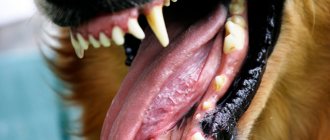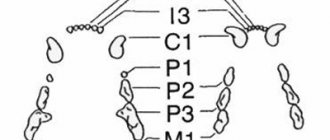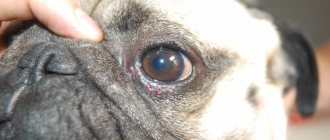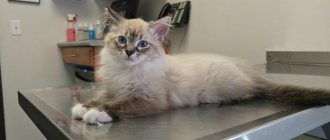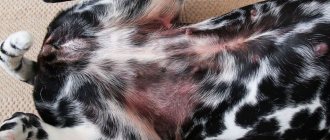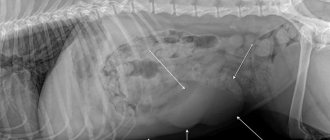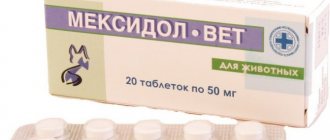The use of ultrasound is one of the effective technologies for removing tartar on a dog’s teeth. The accumulation of deposits is very dangerous, as it can cause disturbances in the functioning of the digestive tract. Your pet's teeth should be brushed at least once a year. The procedure will help not only avoid the loss of fangs, but also maintain their health.
Cleaning your teeth with an ultrasonic device is the best way to get rid of plaque and tartar.
How does a stone appear?
Plaque on the teeth of pets can appear for various reasons. The main ones:
- Poor nutrition. At home, dogs are most often given soft food. You don't need to chew it for a long time. Because of this, the natural self-cleaning of teeth does not occur.
- High level of saliva acidity. Because of this, animals are most susceptible to caries. At the same time, this affects the formation of calcium phosphate on the teeth.
- Sugar. If your pet's diet contains a lot of sweets, a favorable atmosphere is created for bacterial development. A plaque forms on the enamel, which subsequently hardens and turns into stone.
- Problem with the structure of the jaw. Crooked or too tightly spaced teeth, incorrect bite – all this leads to digestive problems, which further provoke the formation of tartar.
Important! Tartar often forms due to poor oral hygiene. You need to regularly brush your pet's teeth with special brushes and toothpaste.
One of the factors causing stones in dogs is eating only soft food.
Possible danger
Due to the formation of tartar, oral diseases can develop:
- periodontitis;
- periodontal disease;
- stomatitis;
- gingivitis.
All these pathologies cause severe pain to the animal and negatively affect the functioning of the gastrointestinal tract.
Prevention of tartar formation in dogs and cats
To prevent the occurrence of tartar, daily brushing of your dog’s or cat’s teeth using brushes and pastes intended for animals;
You can also use special pastes used in veterinary dentistry, which simply need to be applied to the teeth once a week. The rate at which plaque and tartar appear is affected by your pet’s diet and activity. In nature, predators use their teeth to capture, hold prey and chew bones, veins, etc. Therefore, if an animal receives exclusively soft and crushed food instead of solid food (canned food, spiders, cereals, soups), the teeth are not cleaned properly.
The load on all groups of teeth is important, so the diet of dogs and cats should contain foods that they can gnaw, chew, bite, etc. Also, according to research, physical activity, due to its effect on water-salt metabolism, prevents the formation of plaque and tartar, so you need to walk your dog more often.
It is important to monitor the condition of your pet’s oral cavity and periodically examine its teeth for the presence of plaque or tartar and promptly contact a veterinary clinic where teeth will be cleaned with ultrasound in order to avoid their loss, severe inflammatory processes in the pet’s oral cavity, disorders of the gastrointestinal tract.
Back
In what cases is cleaning indicated?
Ultrasonic tartar removal in dogs is used in the following cases:
- there was an unpleasant odor from the oral cavity;
- yellowing of the enamel became noticeable.
When the first signs of tartar formation are detected, it is recommended to take the dog to the veterinary clinic. The pet must undergo a preliminary examination to exclude the development of diseases associated with the digestive system.
If no contraindications are found, the owner will be offered ultrasonic cleaning of the pet’s teeth using a scaler. This is a device that is designed to destroy tartar and plaque.
When does a dog need ultrasonic teeth cleaning?
Ultrasound cleaning of dogs' teeth is indicated when there is an unpleasant odor from the mouth and if there is plaque and tartar. You should visit the dentist not only because of plaque, but also to detect other oral problems. The appearance of an unpleasant odor may not be associated with dental disease, but may be a signal from the digestive system. Tartar is the beginning of inflammatory processes.
Preparatory activities before the procedure
The use of painkillers, regardless of the drug, requires mandatory biochemical blood tests and ultrasound of the heart. It is necessary to determine all contraindications to the procedure.
In some cases, the veterinarian prescribes a course of medications that increase the dog’s immunity. This makes it possible to cope with the effects of anesthesia better and without consequences.
A prerequisite is that the animal is hungry 12 hours before brushing its teeth. This does not depend on where it will be carried out: at home or in a hospital. But liquid is given in unlimited quantities.
Preliminary activities
Ultrasonic cleaning of a dog's teeth requires preliminary preparation. It consists of the following actions:
- Half a day before cleaning, you need to completely stop giving your dog food. But it is important to drink plenty of water.
- It is recommended to organize outdoor games for your pet two hours in advance so that he is a little tired.
This preparation will be required if cleaning is carried out without anesthesia. By following a diet, you can prevent the occurrence of vomiting during the cleansing process; the pet will not actively resist.
Important! If the procedure is performed without anesthesia, additional preparation will be required. It consists of conducting an examination to determine the dog’s sensitivity to anesthesia.
Cleaning under anesthesia is recommended only for large dogs.
Carry out the procedure in a clinic or at home in Moscow
The veterinary hospital "Doctor-Vet" offers on-site services for cleaning a dog's teeth without anesthesia at home with conditions convenient for owners. The specialist’s visit is carried out after clarifying the data on the condition and biometric characteristics of the animal and agreeing on a session time that suits the owner. The doctor takes the instruments and painkillers and antiseptics carried in a portable cooler.
Ultrasonic teeth cleaning in dogs takes place without gel or infiltration anesthesia, if the four-legged family member does not behave aggressively and does not have advanced diseases. He feels comfortable in a home environment, surrounded by the familiar smells of his territory. Only in case of severe pain and damage to the oral cavity will it be necessary to transport it to a pet salon. In the veterinary dentist's office, high-precision diagnostics are possible to make a decision on extraction or restorative therapy on teeth.
Our features:
- modern equipment and qualified medical staff;
- availability of round-the-clock veterinarian home calls and consultations;
- assistance in selecting optimal prevention;
- minimizing stress.
How it goes
Cleaning your pet's teeth with ultrasound is carried out in specialized clinics. To do this, you must check the availability of a license and compliance with sanitary standards.
Specialists should carry out work only in disposable gloves, using sterile attachments. This is an important point to avoid infection during cleaning.
Important! Cleaning is carried out without anesthesia only if the pet is small and does not react aggressively to strangers.
If the procedure is carried out without anesthesia, the owner can be present during it. The dog is first swaddled tightly, then the jaws are fixed. The procedure includes several steps:
- The first consists of the process of cleaning the surface from stone, bleaching using wave bonds. This technology makes it possible to quickly and efficiently clean both the outer and inner sides of the teeth.
- The second includes treatment with antiseptic drugs.
- If the enamel surface is uneven, plaque settles on it very quickly. To avoid the problem, you need to achieve a smooth enamel surface. This is done by polishing, which is carried out in the third stage.
- Treatment. For this purpose, preparations with fluoride are used. They are necessary to protect against thinning and decreased sensitivity after the procedure.
Important! You can order an at-home cleaning service.
But this procedure cannot be done at home if we are talking about a large dog. In such situations, general anesthesia under the supervision of specialists will be required.
Work with ultrasound should only be carried out by specialists
Piezo scaler LM-ProPower UltraLED (Sweden)
The level of equipment affects the behavior of dogs and the quality of teeth cleaning.
I use original equipment from LM Dental.
| Working I | Average competitor | |
Without your help!I'm working! Just look. you need the right approach and patience extra hands make the animal nervous! | ||
10 years of experienceexclusively for cleaning dogs teeth experience grows | ||
YOU are present while brushing your teeththe pet knows that you are nearby and calms down You will be convinced that all teeth are cleaned only with ultrasound! | ||
Without anesthesia! Ultrasound!This is a safe removal of tartar and deposits from the surface of the tooth and under the gum without mechanical impact on enamel Every dog can be trained to brush its teeth without anesthesia! | ||
All distant teeth are cleanedrequires a lot of patience! | ||
All teeth are cleaned from the insideIf you don’t brush from the inside, brushing your teeth itself is pointless | ||
+ Polishing of all teeth!The inside of the teeth is also polished! polishing improves the quality of teeth cleaning influences further dental care | ||
The duration of teeth brushing depends on:dog character dental conditions dog age dog sizes additional breaks individual characteristics (dogs are brought in with broken paws that will never heal, with implants, with spinal problems, etc.) | 90 min. | 15 minutes. |
World class equipmentaffects dog behavior and quality of teeth cleaning I use original LM Dental equipment | Sweden | China |
Equipped separate roomthe pet behaves calmer and more patient the owner is nearby | ||
Transparent priceeverything is accessible and understandable | ||
Is anesthesia necessary?
Anesthesia should only be used in extreme cases. Most often, it is only needed by large breed dogs, which can cause harm to themselves and others. Such pets cannot be restrained with simple restraints.
Rules for the use of anesthesia
Anesthesia should not be given to a pet without prior examination. It is necessary to do an ultrasound examination of the kidneys and heart, and undergo laboratory tests. It is important to first make sure that the animal is completely healthy and can withstand the load.
The most important problem when performing the procedure on small breed dogs is the danger of an overdose of the anesthesia drug. Often, pet owners sign contracts that state that they are responsible for the death of their pet due to the wrong dose. In addition, you need to be prepared for the fact that after anesthesia the dog takes a long time to recover. Despite the fact that the procedure is faster, the dog tolerates it less well.
The sooner the puppy is accustomed to the procedure, the easier it will be for him to tolerate it. In this regard, it is recommended to do the first cleaning immediately after changing baby teeth.
Pros and cons of the procedure
Ultrasonic cleaning has both pros and cons. The main advantage is eliminating the risk of developing diseases in the oral cavity. In addition, after cleaning the teeth, the dog becomes more attractive in appearance.
But there is also a drawback to the procedure. It involves the use of drugs for anesthesia. Not every owner is ready to give permission for it. But in some cases it is impossible to carry out cleaning without anesthesia.
Preparing for ultrasonic teeth cleaning
Before undergoing the procedure, a dog or cat needs to consult a surgeon or veterinary dentist, preferably one who will perform ultrasonic teeth cleaning.
The veterinarian will assess the amount and nature of plaque, the condition of the gums and mucous membranes and prescribe appropriate treatment. In the absence of tartar, the use of special pastes for cleaning teeth may be recommended; in the presence of certain inflammatory diseases of the oral cavity, a course of antibiotics and the use of other drugs may be required.
If necessary, an X-ray examination will be performed to examine the condition of the roots of the teeth and jaw.
Result of the cleaning procedure
On average, the effect of cleaning can be observed within six months. But this is only possible if the specialist who performed the procedure has fulfilled all the technology requirements.
Effect duration
The procedure is not very pleasant for animals, so not all owners are ready to bring their pet to it. To avoid plaque formation, you can use preventive measures:
- The animal should eat not only soft canned food, but also dry food.
- You need to brush your dog's teeth every day with a special brush.
- It is necessary to give your pet special treats that are intended for cleaning.
Important! Once every six months you need to take your dog to the veterinarian to have the oral cavity sanitized.
Compliance with hygiene standards helps maintain the effect
How often should you brush your teeth?
The cleaning procedure should not be carried out too often. It is recommended that this should be no more than once every six months. If you brush your pet's teeth regularly, you can get them cleaned once every two years.
Important! You should not brush your pet's teeth with a regular human toothbrush. You need to use only special ones that are sold in pet stores.
